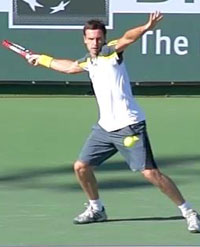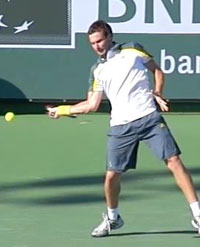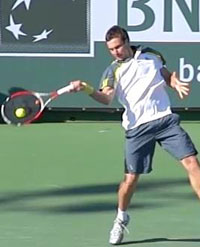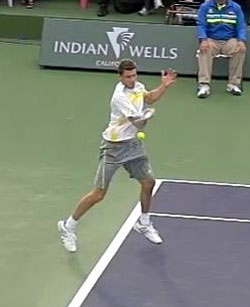|
TennisOne Lessons A Great Preface to Much Awaited Best Seller Michael McDowell Sometimes called the 5th Slam, The PNB Paribas Open in Indian Wells is the most attended tennis event outside of the 4 Grand Slams. Expecting between 375,000 and 390,000 fans in 2013, organizers have in place plans which could increase capacity and attendance to a number that exceeds that of Wimbledon and the French Open. So, what draws hundreds of thousands of tennis fans to the desert for this tournament. Heading into the first weekend, the major stories are yet to be told.
But, while these tales are yet to unfold, many entertaining side stories have already emerged to capture the imagination of tournament goers. For me, as a fan of aggressive, attacking tennis, three matches especially caught my attention in these days that serve as a prelude to the more compelling matches ahead. Has Ernests Gulbis Brought the Party Back to the Tennis Court?By his own admission, sometimes Ernests has been a bit too enthusiastic in his extracurricular activities to the detriment of his on court results. At least that seems to be what he is saying (Google “Ernests Gulbis party and judge for yourself). Anyway, after skipping the Australian Open and taking a month to work on his game, the talented Latvian has come out firing (cursing, breaking racquets, and winning matches).
On the heels of a marathon at Del Ray Beach where he won 8 matches en route to winning the ATP event as a qualifier, Ernests Gulbis headed to Indian Wells. Since arriving, he has won two tough 3 set qualifying matches before knocking off 34th ranked Feliciano Lopez 6-3, 6-2 in the first round of the main draw. By my count that’s 11 matches in less than two weeks, whew. Gulbis has always had tremendous weapons: an incredible serve (see my earlier article on T1) and beautiful groundstrokes. But this week his forehand seems even more lethal than before.
As the ball is bouncing Ernests throws his non-dominant hand forward and stretches his racquet arm toward the back wall. Next he folds his arm in and drops the racquet into the slot almost directly behind the ball. Then without pausing in this position, Gulbis pivots on his load foot and drives the right side of his body (hips, shoulders,and racquet arm) forward to execute a perfect double bend forehand. Finally, when he sets up behind the baseline, his swing path culminates in a very low follow through between shoulder and waist on most balls. The resulting ball is both heavy and penetrating — a deadly combination! Daniel Brands’ Upsets Marcos Baghdatis
Daniel Brands’ straight set win over Marcos Baghdatis certainly caught most fans by surprise. Although this may in part be explained by a balky shoulder for which Baghdatis received treatment after the first set, the German Qualifier was extremely impressive. Using a classic first strike strategy, the German backed up his big serve with an equally aggressive forehand, consistently controlling the center of the court and moving Baghdatis out of position. The 6’5” Brands used his unorthodox serve motion to consistently rocket 130+ mph first serves that kept the Cypriot star on his heels. Not only were his serves powerful, but his first serve percentage was 66% for the match; furthermore, when Marcos did put the ball back in play, he was rarely successful at getting to his opponent’s backhand. On all but the widest angles, Brands displayed excellent footwork for a big man and ran around his backhand to crack devastating inside out or inside in forehands. This strategy worked so well that the 35th ranked Baghdatis only had one break opportunity in the match, an opportunity which he failed to convert. A Good Example or a Horrible WarningThe third match that piqued my interest this week proved to be something of a cautionary tale. Friday was a chilly, windy day in the desert; and those conditions often make for tough times on the outer courts at Indian Wells. This was case for Slava Shvedova in her match against Ukrainian qualifier Lesia Tsurenko. The #31 seed got off to just about as bad a start as is possible – losing her first game at love. While she did manage to break right back when her opponent too had trouble serving on the sun side, this was the only game she would win in the first set. Bear in mind that this is a top woman player. In fact, this is the only woman to ever win a “golden set” in a professional tennis tournament. At Wimbledon last summer, Shvedova won 24 straight points in the first set on her way to a 6-0, 6-4 win over #10 seed Sara Errani. Errani said that she wasn’t even playing that poorly; and she went on to describe Shvedova’s serves and groundstrokes as Williams like. She also speculated that Slava could win the tournament if she continued to play at that level. Of course, rising to such a level is a difficult task. Still, on her way to the Championship, it did take Serena 3 sets to defeat Shvedova in the next round. But that was then and this is now.
On this day, Slava’s high risk, high return game didn’t pay off. She hit far too many balls in the net; and failed to effectively attack weaker balls when her opponent gave her opportunities. While her backhand was pretty solid, the forehand seemed less consistent; and at times she appeared to be reaching for the ball or not going for her shot on that side. Finally, as is often the case on windy days, Shvedova was too often somewhat off balance and out of rhythm as she positioned to the ball. Her usually good footwork seemed to suffer most frequently when Tsurenko would give her an off pace ball that the wind would catch. At various times throughout the match Slava’s confidence seemed to wane. Her body language was not the best all day, with the most obvious example coming in the final set when she lost the first game on a double fault. As she walked to her chair, she put her finger to her temple as though she were shooting herself in the head. While the situation wasn’t that serious, the young Kazakh player did seem to repeatedly “shoot herself in the foot” with questionable shot selection and tentative play. Clearly, in this match, Tsurenko was better able to tame the elements as she prevailed 6-1, 3-6, 6-1. She was able to blunt the power of Shvedova’s strokes by blocking balls back to her opponent and letting the wind work its magic. She likewise went for more conservative targets and tried to minimize the inevitable errors. Finally, she seemed to be able to shake off those errors a bit more quickly and find her way to an ugly win as she knocked out a seeded player and made it through to the second round to play Petra Kvitova in a 3rd round match. So much about playing under windy conditions involves good footwork, but even more important may be the right attitude. Although I can't confirm this, it's a statement attributed to Andre Agassi, one of the best wind players of all time (he grew up playing in the desert winds of Las Vegas). On one particularly blustery day in New York, where Andre came through, when asked about the very windy conditions, Andre remarked, "What wind?" The Plot ThickensSo now the tournament shifts into high gear as we get to see Federer, Azarenka, Ferrer, and Kerber in day matches on Saturday, while Nadal and young American Sloane Stephens highlight the night session. I can hardly wait. See you there. |
||||||||



